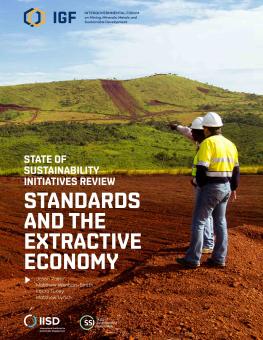
State of Sustainability Initiatives Review: Standards and the Extractive Economy
This report examines voluntary sustainability initiatives (VSIs), and their aim to promote sustainable production practices in the mining sector.
In the last decade, the international community has increasingly recognized the central role of sustainable consumption and production in the implementation of sustainable development.
As a result, the mining sector, like other primary commodity sectors, has seen a wide variety of multistakeholder, market-based supply chain initiatives arise. These are called voluntary sustainability initiatives (VSIs), and they aim to promote sustainable production practices, often at the global level.
The rapid growth in the number of VSIs has been cause for concern for some civil society and public-sector players, as well as for the private sector, as keeping track of the sheer volume and diversity of initiatives is challenging and costly. Because this monitoring is difficult, the value of VSIs to society and the marketplace may suffer as a result.
This report dives headfirst into this complex and quickly moving space to provide readers with synthesis and analysis across a number of areas. We have applied a distinctly rigorous methodology across 15 major initiatives, capturing not only the content (environmental, social and business dimensions)—where most other analyses end off—but also the level of obligation demanded by the initiative to implement sustainability actions. Our review is comprehensive, revealing the different strengths (and often the different intended purposes) of VSIs and the challenge of finding a one-size-fits-all initiative.
For recent developments on the standards covered in this report, please visit the individual standards' websites:
- Aluminium Stewardship Initiative (ASI)
- Bettercoal (BC)
- Initiative for Responsible Mining Assurance (IRMA)
- International Council on Mining and Metals
- International Finance Corporation Environmental and Social Performance Standards
- MAC's Towards Sustainable Mining
- Responsible Jewellery Council
- Cornerstone Standards Council
- Fair Stone
- Natural Stone Council
- The Forest Trust Responsible Stone Programme
- XertifiX
- Fairmined
- Fairtrade Gold and Silver
You might also be interested in
Securing India's Copper Supply
This policy brief emphasizes the need for India to develop a comprehensive copper strategy.
Rethinking Investment Treaties
International investment treaties and their investor–state dispute settlement (ISDS) system are facing growing scrutiny. But what would an alternative system—one fit for the challenges of the 21st century—look like?
The Responsible Agricultural Investment Tool for Agribusiness
This tool aims to support agribusinesses in aligning their practices, procedures, and operations with principles of responsible investment in agriculture and food systems.
New tool empowers businesses to make food systems sustainable
The Responsible Agricultural Investment (RAI) Tool for Agribusiness helps business leaders put principles into practice in the drive to improve sustainability in agrifood systems.